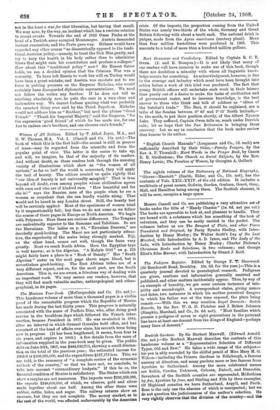Women of All Nations. Edited by T. Athol Joyce, M.A.,
and N. W. Thomas, M.A. Vol. I. (Cassell and Co. 155. net.)—The book of which this is the first half—the second is still in process of issue—may be regarded from the scientific and from the popular point of view. The latter is the easier to take up, and will, we imagine, be that of the majority of its readers. And without doubt, as these readers look through the amazing variety of illustrations which show us "the women of all nations," as far as half the world is concerned, they will apply the test of beauty. The editors remind us quite rightly that "our idea of beauty is not universally accepted." That is true beyond all doubt, even among peoples whose civilisation agrees with ours and who are of kindred race. "How beautiful and fat she is!" says the Russian man of the people when he see a woman so corpulent that she can hardly waddle along. That would not be heard in any London street. Still, the beauty test will be certainly applied. Most of the specimens of women tried by it unquestionably fail ; but then we do not come as we follow the course of these pages to Europe or North America. We begin with Polynesia. Here there are curious differences. The Tongans are undoubtedly superior to the Samoans and Tahitians. So are the Hawaiians. The ladies on p. 61, "Hawaiian Dancers," are decidedly good-looking. The Maori are not particularly attrac- tive, the superiority of the males being strongly marked. Fiji, on the other hand, comes out well, though the faces vary greatly. Next we reach North Africa. Here the Egyptian type is well known ; so is the Algerian. "A Kabyle Girl" on p. 225 might fairly have a place in a "Book of Beauty." Her "South Algerian" sister on the next page shows negro blood, but is nevertheless good-looking. The East African tribes are of a very different aspect, and so, for the most part, are the South American. This is, we are aware, a frivolous way of dealing with an important work. We may assure our readers, however, that they will find much valuable matter, anthropological and ethno- graphical, in its pages.














































 Previous page
Previous page